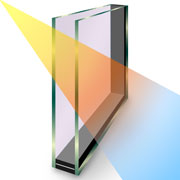low-emissivity glass
Low-emissivity (low-E) glass is glass that has a low-emissivity coating applied to it in order to control heat transfer through windows. Windows manufactured with low-E coatings typically cost about 10–15% more than regular windows, but they reduce energy loss by as much as 30–50%.
 |
A low-E coating is a microscopically thin, virtually invisible, metal or metallic oxide layer deposited directly on the surface of one or more of the panes of glass. The low-E coating reduces the infrared radiation from a warm pane of glass to a cooler pane, thereby lowering the U-factor of the window. Different types of low-E coatings have been designed to allow for high solar gain, moderate solar gain, or low solar gain. A low-E coating can also reduce a window's visible transmittance unless you use one that's spectrally selective.
To keep the sun's heat out of the house (for hot climates, east and west-facing windows, and unshaded south-facing windows), the low-E coating should be applied to the outside pane of glass. If the windows are designed to provide heat energy in the winter and keep heat inside the house (typical of cold climates), the Low-E coating should be applied to the inside pane of glass.
Window manufacturers apply low-E coatings in either soft or hard coats. Soft low-E coatings degrade when exposed to air and moisture, are easily damaged, and have a limited shelf life. Therefore, manufacturers carefully apply them in insulated multiple-pane windows. Hard low-E coatings, on the other hand, are more durable and can be used in add-on (retrofit) applications. The energy performance of hard-coat, low-E films is slightly poorer than that of soft-coat films.
Although low-E coatings are usually applied during manufacturing, some are available for do-it-yourselfers. These films are inexpensive compared to total window replacements, last 10–15 years without peeling, save energy, reduce fabric fading, and increase comfort.
